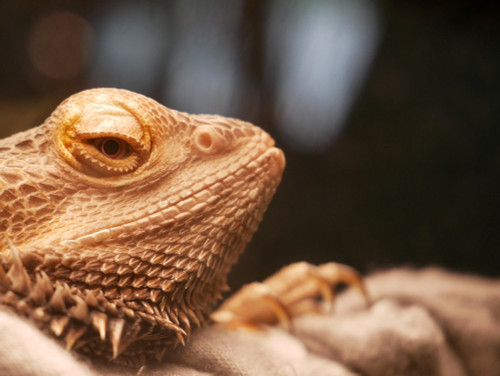Rise and Shine
Posted by Ailie Mackenzie on 12th Aug 2021
Have you ever woken up from a long nap and had no idea where you were or what year it was? Now imagine waking up from a three-month nap where you might not have even moved! Although the annual experience of brumation is totally natural for many of your reptiles, there are still some things you can do for them to welcome them back to the world of the wakeful for another season.
What is Brumation?
Brumation is the innate ‘sleep’ response of some reptile and amphibian taxa to sustained decreases in temperature during winter [1]. As these ectotherms, or cold-blooded animals, rely on external heat sources to fuel their daily activity, temperature drops below their tolerance threshold will trigger a state of dormancy [1] – kind of like how we’d really prefer not to move when it’s cold and we’re rugged up in a blanket! During this period, ectotherms will lower their heart rate and metabolism to use as little energy as possible, relying on fat reserves to see them through to spring with minimal effort [1]. In this way, they can survive seasonal changes in climate and lack of food, water and even oxygen [1,2] by literally sleeping their way to better days!
Brumation is also highly beneficial to reproductive success in many reptile and amphibian species, sparking the production of reproductive cells and increasing the chances that females will lay eggs [3,4].
How Do I Help My Reptile Wake Up?
In the wild, reptiles will begin to emerge from their slumber when their environmental temperature consistently exceeds a particular point [5]. However, in an indoor captive setting, such increases in temperature and light must be replicated by the keeper. Some reptiles will jump the gun and decide to get themselves out of bed without you, but others might prefer to catch a few extra Zs while they can.
If you want to wake your reptile out of brumation yourself, the most important thing to remember is that any changes in enclosure conditions should be done slowly. Over at least a few days, gradually increase the light and temperature in your enclosures to pre-winter levels, using a thermostat to ensure stability. Your reptile may be lethargic, and may not even exit brumation immediately, but in a majority of cases, this is nothing to worry about. Although your first instinct might be to pump them with food, they shouldn’t have lost too much condition, and should instead be offered water. If they appear particularly dehydrated, a warm, shallow bath may be helpful, but otherwise, they might prefer to stay dry. Once normal activity has resumed, food can be offered, though they may not be keen to wolf it down straight away – and after spending the past couple of months asleep, can you blame them? Until their appetite is back to normal, pay close attention to how much they are eating so you can adjust the portion sizes if necessary and clean out any leftovers.
One of the best things you can do for your reptile post-brumation is to take them outside. UVB light, obtained through sunlight in the wild, is vital for the synthesis of Vitamin D in reptiles [6]. Though ideal husbandry of most reptile species will include access to UVB lighting within the enclosure, the amount of UVB that reaches the basking spot may be reduced by the materials of the enclosure top [6]. Taking your reptile for a short adventure into the sunlight – whether in hand or tub, let loose or on a leash – will provide them with maximum access to UVB light after their long nap, helping kick their slowed metabolism back into gear.
Now that winter is drawing to a close, it won’t be long before your reptiles are back to their summertime antics (or laziness!), so keep an eye out for their little faces looking back at you from their enclosure, wondering where on earth their next feed has got to!
REFERENCES
- Holden, K. G., Gangloff, E. J., Gomez-Mancillas, E., Hagerty, K. & Bronikowski, A. M. 2021. Surviving winter: Physiological regulation of energy balance in a temperate ectotherm entering and exiting brumation. General and Comparative Endocrinology 307: 113758.
- Fanter, C. E., Lin, Z., Keenan, S. W., Janzen, F. J., Mitchell, T. S. & Warren, D. E. 2020. Development-specific transcriptomic profiling suggests new mechanisms for anoxic survival in the ventricle of overwintering turtles. Journal of Experimental Biology 223(4): jeb213918.
- Calatayud, N., Langhorne, C., Mullen, A., Williams, C., Smith, T., Bullock, L., Kouba, A. & Willard, S. 2015. A hormone priming regimen and hibernation affect oviposition in the boreal toad (Anaxyrus boreas boreas). Theriogenology 84(4): 600-607.
- Sacerdote‐Velat, A., Earnhardt, J., Mulkerin, D., Boehm, D. & Glowacki, G. 2014. Evaluation of headstarting and release techniques for population augmentation and reintroduction of the smooth green snake. Animal Conservation 17: 65-73.
- Doneley, B. 2006. Caring for the bearded dragon. North American Veterinary Conference, Orlando, Florida, USA, 7-11 January 2006. Gainesville, FL, USA: North American Veterinary Conference.
- Michael Burger, R., Gehrmann, W. H. & Ferguson, G. W. 2007. Evaluation of UVB reduction by materials commonly used in reptile husbandry. Zoo Biology 26(5): 417-423.

